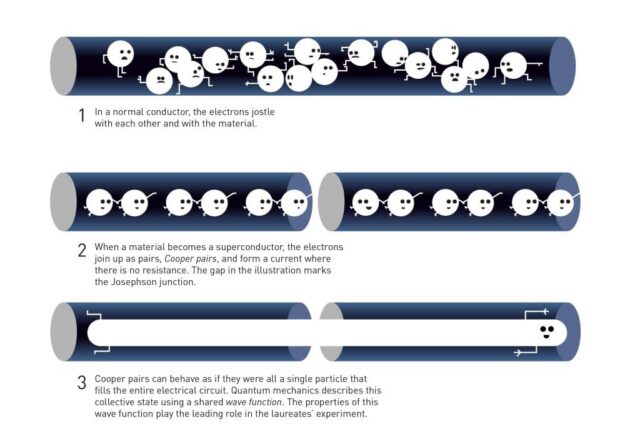(l-r): John Clarke, Michel H. Devoret, and John M. Martinis.
Credit: Niklas Elmehed/Nobel Prize Outreach
Exploring Quantum Effects on Macroscopic Scales
Researchers John Clarke, Michel H. Devoret, and John M. Martinis have pioneered the demonstration that quantum phenomena, such as quantum tunneling and energy quantization, can manifest at macroscopic levels, not just isolated particles.
Clarke received his PhD from the University of Cambridge and subsequently joined the University of California, Berkeley, as a postdoctoral researcher before becoming a faculty member in 1969. By the mid-1980s, Devoret and Martinis had become part of Clarke’s team, with Devoret serving as a postdoc and Martinis as a graduate student. Together, they explored the potential for observing macroscopic quantum tunneling using a specialized circuit known as a Josephson junction. This device is critical in various fields, including quantum computing, sensing, and cryptography.
A Josephson junction, named after British physicist Brian Josephson, who received the Nobel Prize in Physics in 1973, consists of two semiconductor materials separated by a thin insulating layer. Even with this minute separation, electrons can tunnel through the insulator to establish a current. This phenomenon typically occurs at very low temperatures when superconductivity allows electrons to pair as “Cooper pairs.
The team developed a microchip featuring an electrical circuit-based oscillator, roughly one centimeter in size, akin to a quantum version of a traditional pendulum. One of their significant hurdles was minimizing noise within their experimental setup. They initially applied a weak current to the junction and measured the voltage, which began at zero. Gradually increasing the current, they timed how long it took for the system to escape its enclosed state and generate a measurable voltage.

Credit: Johan Jarnestad/The Royal Swedish Academy of Sciences
The research findings revealed that as the device’s temperature decreased, the average current increased, which was expected. However, once the temperature dropped to a critical threshold, the device transitioned into a superconducting state where the average current became independent of the temperature—a clear indication of macroscopic quantum tunneling.






